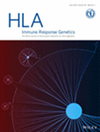投稿信息
稿件收录要求
HLA publishes full-length original articles, brief communications, commentaries and occasional reviews on research in: immunogenetics of cell surface antigens; ontogeny and phylogeny of the immune system; immunogenetics of cell interactions; functional aspects of cell surface molecules and their natural ligands, such as cytokines, adhesion molecules and activation antigens; role of tissue antigens in immune reactions in vitro and in vivo, including experimental and clinical transplantation; and relationships between normal tissue antigens and tumor-associated antigens.The journal emphasizes genetic control of immune response, disease susceptibility and genetics, biochemistry and molecular biology of alloantigens and leukocyte differentiation. Manuscripts are invited on molecules expressed on lymphoid cells, myeloid cells, platelets and non-lineage-restricted antigens. The immunogenetics of histocompatibility antigens in humans and experimental animals and their tissue distribution, regulation and expression in normal and malignant cells and antigens as markers for disease are of major interest.
Aims and Scope
HLA publishes full-length original articles, brief communications, commentaries and reviews covering all aspects of genetic control of immunity. The scope includes functional, biochemical, and genetic studies on molecules of the immune system, including cell surface receptors and their ligands, and encompassing cytokines, and chemokines, adhesion and co-stimulating molecules, antigen receptors such as TcR, NKR, CD1, PAMPs, Igs, KIR, and genes and products of the major histocompatibility complex including classical and non-classical HLA molecules. Papers should describe original research in vitro, or in animal models, or be clinical studies reflecting genetics of immunity in solid organ or haematopoietic stem cell transplantation, autoimmunity, infectious immunity, allergy, tumour immunity, vaccine science, pregnancy and disease susceptibility. The journal emphasis is on understanding genetic control of immunity through:
· Immunogenomics including gene organisation, phylogeny, evolution, regulation, polymorphism particularly where it affects expression and function, population genetics, gene markers (eg.microsatellites and SNPs) and typing applications or methodology.
· Protein or antigen expression and biochemistryof immunologically important molecules including post-translational regulation, cell surface expression, isoforms, serology, tissue expression, cell lineage relationships particularly defined by leucocyte differentiation antigens, cell activation and differentiation markers, myeloid and lymphoid cell surface antigens, platelet antigens, thymic markers and non-lineage cell surface molecules.
· Structure and function of molecules that control immune responsesincluding cell surface molecules and their ligands, adhesion molecules, cytokines, chemokines, antigen receptors such as TcR, immunoglobulins, NKR, Toll-like receptors, HLA, KIR, CD1, MICA/B, PAMPs, Complement and other immune effector molecules. Modulation of immune responses by pathogens such as decoy receptors, cytokine analogs and inhibitors of apoptosis or other cellular functions.
· Immunogenetic tools including new genes, sequences, mAbs, polymorphism databases particularly HLA alleles, population data, HLA-peptide repertoires in health and disease, definition of minor histocompatibility antigens, allelic variants, gene maps and bioinformatics.
Review articles, Commentaries, Brief communications and People in Immunogenetics. Review articles (maximum 12 printed pages) on recent developments in areas covered by the journal are invited. Suggestions are welcomed in the form of a one-page synopsis submitted to the Reviews Editor. Commentaries briefly explore important current topics.Brief communications are encouraged for reporting gene sequences, MHC peptide motifs and studies of monoclonal antibodies and disease susceptibility. People in Immunogenetics (maximum 2 printed pages) highlight the scientific contributions of one or more people in relation to a specific recent event involving the person(s).
Reports of meeting or workshops. Contact the Editor-in-Chief before the meeting to determine acceptability.
Submission of sequence data to GenBank or the European Nucleotide Archive (ENA). Original nucleotide or amino acid sequence data described in manuscripts must also be submitted to GenBank or ENA before submission. Manuscripts containing DNA or protein sequences without an accession number are not accepted. Sequences of new alleles should meet the requirements of international nomenclature committees e.g. New HLA alleles require sequencing of complete genes for their proper definition and should have been named by the WHO Nomenclature Committee for Factors of the HLA System.
Rapid publication.This is a large field, and a journal is needed that can publish the latest results in the shortest possible time. We therefore strive to minimize publication time, ensuring that articles on tissue antigens are gathered quickly in one place and are thereby accessible to everyone interested in this field.
Keywords
HLA, human leukocyte antigen, genetics, immunity, immunogenetics, antigen receptors, infectious immunity, autoimmunity, disease susceptibility, MHC, non-human MHC, transplantation, polymorphism
Abstracting and Indexing Information
- Abstracts in Anthropology (Baywood Publishing)
- Abstracts on Hygiene & Communicable Diseases (CABI)
- Academic Search (EBSCO Publishing)
- Academic Search Alumni Edition (EBSCO Publishing)
- Academic Search Premier (EBSCO Publishing)
- AgBiotech News & Information (CABI)
- AgBiotechNet (CABI)
- Animal Breeding Abstracts (CABI)
- BIOBASE: Current Awareness in Biological Sciences (Elsevier)
- Biological Abstracts (Thomson Reuters)
- BIOSIS Previews (Thomson Reuters)
- CAB Abstracts® (CABI)
- CABDirect (CABI)
- CAS: Chemical Abstracts Service (ACS)
- CSA Biological Sciences Database (ProQuest)
- Current Contents: Life Sciences (Thomson Reuters)
- Dairy Science Abstracts (CABI)
- Embase (Elsevier)
- Global Health (CABI)
- Helminthological Abstracts (CABI)
- Immunology Abstracts (ProQuest)
- Index Veterinarius (CABI)
- InfoTrac (GALE Cengage)
- Journal Citation Reports/Science Edition (Thomson Reuters)
- MEDLINE/PubMed (NLM)
- Nutrition Abstracts & Reviews Series A: Human & Experimental (CABI)
- Pig News & Information (CABI)
- Protozoological Abstracts (CABI)
- PubMed Dietary Supplement Subset (NLM)
- Review of Medical & Veterinary Entomology (CABI)
- Review of Medical & Veterinary Mycology (CABI)
- Rural Development Abstracts (CABI)
- Science Citation Index (Thomson Reuters)
- Science Citation Index Expanded (Thomson Reuters)
- Tropical Diseases Bulletin (CABI)
- Veterinary Bulletin (CABI)




